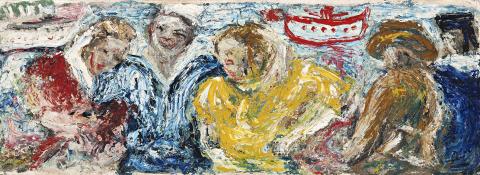YANKEE WITH GIRLS, AUSSIES WITHOUT, 1942
DANILA VASSILIEFF
oil on muslin on board
26.0 x 68.5 cm
inscribed verso: “SOLDIERS AND SAILORS” 1942
Estate of Elizabeth Vassilieff, New South Wales
Bay East Auctions, Sydney, 21 March 2010, lot 256
Private collection, Melbourne
Oil Paintings by Danila Vassilieff: 74 Paintings from the Collection of Elizabeth Vassilieff – Wolf, The Macquarie Galleries, Sydney, November 1978, cat. 19 (label attached verso)
Moore, F. St. J., Vassilieff and His Art, Oxford University Press, Melbourne, 1982, p. 153, cat. p211 (dated as 1945)
Moore, F. St. J., Vassilieff and his Art, MacMillan, Melbourne, 2012, p. 206, cat. 281
Danila Vassilieff’s life was as vibrant as his art. A Lieutenant Colonel in the Cossack forces, he fought the Bolsheviks, was captured, then escaped by swimming the river Volga. Subsequently he lived for periods in Armenia, Persia, Shanghai, Australia, Europe, and South America.1 En route, Vassilieff trained and exhibited as an artist before his re-arrival in Australia in 1937 where he soon befriended John and Sunday Reed and many of the new generation of artists – Nolan, Tucker, Boyd, Hester, Bergner and Perceval. His arrival brought the expressionist tenor of modern art to Melbourne and the younger artists were galvanised by his example. Some of their most powerful wartime images are directly due to Vassilieff’s influence.
For the former soldier, the return of war to Vassilieff’s life in 1939 was deeply disturbing, amplified further by Germany’s invasion of Russia two years later when he ‘experienced a surge of patriotism (and his) work became impassioned and distorted.’2 In June 1942, the South-West Pacific Area military headquarters was established in Melbourne and the population swelled with 30,000 American troops. As the writer Max Harris reminds us, ‘Australia was not a pretty place in the 1940s. It was narrow, philistine, xenophobic, and supremely intolerant.’3 Melbourne changed overnight and tensions between local servicemen and these glamorous imports soon reached boiling point. There were ‘terrible fights, real hatred’ between the Australians and the Americans whom the local boys saw as stealing their girls, ‘(but) the yanks had the money … they looked wonderful … and we were young and fickle.’4 Just prior, in May 1942, an American GI Eddie Leonski had strangled three women in or around Melbourne’s CBD meaning tensions were already simmering before the arrival of these extra troops.
Out of this tumult comes this swirling and little known painting by Vassilieff, bristling with latent energy. Painted by the bay, an obvious assignation spot for the amorous, a buoyant US sailor has a brightly dressed girl on each arm. ‘The Americans were quite uninhibited … and had no qualms about kissing and cuddling their girls in public. It gave the city an erotic charge underscored by the closeness of death; a reckless gaiety, of pleasures taken swiftly, wantonly.’5 To the right of the happy trio stands an Australian soldier and his navy mate. Their disdain for the affair is palpable. The date of 1942 for Yankee with Girls, Aussie Without was listed in a major exhibition of Vassilieff’s works at the Macquarie Galleries in Sydney, however his biographer Felicity St John Moore cites it as 1945. Considering the flashpoint of 1942, it appears more likely that the earlier date is accurate. Due to wartime restrictions, art materials were already in scarce supply in these years and Vassilieff’s use of muslin over board to mimic the effect of canvas makes Yankee with Girls, Aussie Without stand out as an important DIY wartime relic as much as it is an expressively rendered scene by this influential Melbourne artist.
1. Vassilieff lived in northern Australia as a farmer and labourer from 1923 to 1929.
2. Moore, F. St. J., Vassilieff and his Art, Oxford University Press, Melbourne, 1982, p. 57
3. Harris, M., ‘Introduction’, Angry Penguins and Realist Painting in Melbourne in the 1940s, Australian National Gallery, Canberra, 1989, p. 6
4. Kelly, J., quoted in: Burke, J., Australian Gothic: A life of Albert Tucker, Knopf, Sydney, 2002, p. 205. Kelly was Janine Burke’s mother.
5. Burke, J., op cit, p. 206
ANDREW GAYNOR
